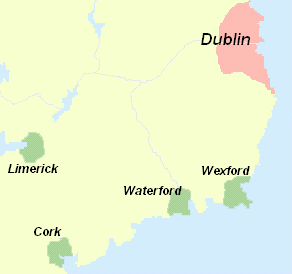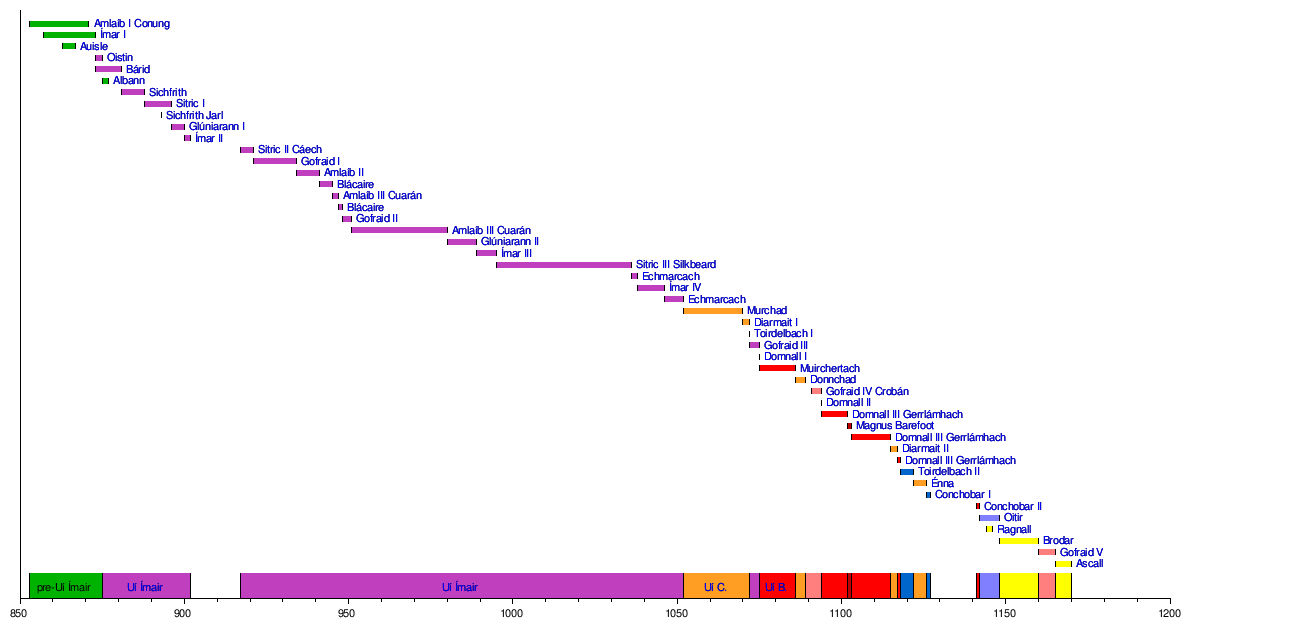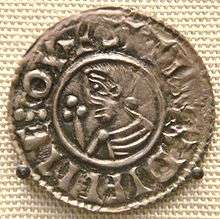Kingdom of Dublin
Vikings invaded the territory around Dublin in the 9th century, establishing the Norse Kingdom of Dublin, the earliest and longest-lasting Norse kingdom in Ireland. Its territory corresponded to most of present-day County Dublin. The Norse referred to the kingdom as Dyflin, which is derived from Irish Dubh Linn, meaning 'black pool'. The first reference to the Vikings comes from the Annals of Ulster and the first entry for 841 AD reads: "Pagans still on Lough Neagh". It is from this date onward that historians get references to ship fortresses or longphorts being established in Ireland. It may be safe to assume that the Vikings first over-wintered in 840–841 AD. The actual location of the longphort of Dublin is still a hotly debated issue. Norse rulers of Dublin were often co-kings, and occasionally also Kings of Jórvík in what is now Yorkshire. Under their rule, Dublin became the biggest slave port in Western Europe.[1][2]
Kingdom of Dublin Dyflin / Duibhlinn | |||||||||
|---|---|---|---|---|---|---|---|---|---|
| 853–1170 | |||||||||
 Maximum extent of Dublin (pink) and other Norse settlements (green) in Ireland. | |||||||||
| Capital | Dublin | ||||||||
| Common languages | Old Norse, Old and Middle Irish | ||||||||
| Religion | Norse paganism Roman Catholicism | ||||||||
| Government | Monarchy | ||||||||
| King | |||||||||
• c. 853–871 (first) | Amlaíb Conung | ||||||||
• ×1170 (last) | Ascall mac Ragnaill | ||||||||
| History | |||||||||
• Established | 853 | ||||||||
• Norman conquest | 1170 | ||||||||
| Currency | Silver penny | ||||||||
| |||||||||
| Today part of | |||||||||
Over time, the settlers in Dublin became increasingly Gaelicized. They began to exhibit a great deal of Gaelic and Norse cultural syncretism, and are often referred to as Norse-Gaels.
The extent of the kingdom varied, but in peaceful times it extended roughly as far as Wicklow (Wykinglo) in the south, Glen Ding near Blessington, Leixlip (Lax Hlaup) west of Dublin, and Skerries, Dublin (Skere) to the north. The Fingal area north of Dublin was named after the Norse who lived there.
In 988, Máel Sechnaill mac Domnaill led the initial Gaelic conquest of Dublin. As a result, the founding of Dublin is counted by some from the year 988, although a village had existed on the site of Dublin since before the Roman occupation of Britain nearly a thousand years earlier.
Coins were minted in Dublin by about 995, and on Mann by about 1025.[3]
In the mid-11th century, the Kingdom of Leinster began exerting influence over Dublin. Though the last king of Dublin was killed by the Norman conquerors of Dublin in 1171, the population of the city retained their distinctiveness for some generations.
Kings of Dublin
| Ruler | Reign | Notes |
|---|---|---|
| Amlaíb Conung | c. 853–871 | Co-king; titled "King of the Foreigners" in 863 |
| Ímar | c. 857–873 | Co-king; titled "King of the Foreigners" in 863; titled "King of the Northmen of all Ireland and Britain" in 873 |
| Auisle | c. 863–867 | Co-king; titled "King of the Foreigners" in 863 |
| Oistin mac Amlaíb* | 873–875 | Probable co-king; not explicitly named as king in the annals |
| Bárid mac Ímair | 873–881 | Probable co-king; titled "head of the Northmen" in 881 |
| Albann^ | 875–877 | Claimed Dublin but never ruled |
| Sichfrith mac Ímair | 881–888 | |
| Sitriuc mac Ímair | 888–893/896 | Rulership disputed by Sitriuc Jarl in 893 |
| Sichfrith Jarl^ | 893-? | Claimed Dublin in 893 but unclear if ever ruled |
| Glúniarann* | ? | Not explicitly named as king in the annals; speculated to have succeeded Sitriuc |
| Ímar ua Ímair | ?-902 | Driven from Dublin in 902 by native Irish |
| Dublin abandoned by the Norse from 902 to 917. | ||
| Sihtric ua Ímair (a.k.a. Sihtric Cáech) | 917–921 | defeated Niall Glundub; also king of Jórvík |
| Gofraid ua Ímair | 921–934 | grandson of Ímar |
| Olaf Guthfrithson | 934–941 | son of Gofraid ua Ímair |
| Blácaire mac Gofrith | 941–945 | |
| Sigtrygg (Sitric) | 941–943 | |
| Amlaíb Cuarán | 945–947 | |
| Blácaire mac Gofrith | 947–948 | restored |
| Gofraid mac Sitriuc | 948–951 | |
| Amlaíb Cuarán | 952–980 | restored |
| Glúniairn | 980–989 | |
| Ivar of Waterford or Sigtrygg Silkbeard | 989–993 | |
| Ivar of Waterford | 994–995 | |
| Sigtrygg (Sitric) Silkbeard Olafsson | 995–1036 | |
| Echmarcach mac Ragnaill | 1036–1038 | |
| Ímar mac Arailt | 1038–1046 | |
| Echmarcach mac Ragnaill | 1046–1052 | |
| Murchad mac Diarmata | 1052–1070 | |
| Diarmait mac Mail na mBo | 1070–1072 | |
| Toirdelbach Ua Briain | 1072 | Member of the Uí Briain; seized overlordship of Dublin following Diarmait's death; given kingship by the Dubliners in 1072; allowed Dublin to be locally ruled by Gofraid mac Amlaíb meic Ragnaill under his overlordship. |
| Gofraid mac Amlaíb meic Ragnaill | 1072–1075 | Member of the Meic Ragnaill (Uí Ímair); ruled under the overlordship of Toirdelbach; expelled from kingship by Toirdelbach in 1075; possibly identical to Gofraid mac Sitriuc, King of the Isles (died 1070). |
| Domnall mac Murchada | 1075 | Member of the Meic Murchada (Uí Chennselaig); gained kingship following the expulsion of Gofraid mac Amlaíb meic Ragnaill; may have seized Dublin without the consent of the Uí Briain, or else ruled under their overlordship; died within the year. |
| Muirchertach Ua Briain | 1075–1086 | Member of the Uí Briain; installed king by his father, Toirdelbach. |
| Donnchad mac Domnaill Remair | 1086–1089 | Member of the Uí Cheinnselaig; seized kingship following death of Toirdelbach; killed in 1089; control of Dublin appears to have been gained by Muirchertach not long afterwards. |
| Gofraid Crobán | c. 1091–1094 | Possibly a close relative of Ímar mac Arailt and thus a member of the Uí Ímair; founder of the Crovan dynasty; ruler of the Isles; seized kingship in about 1091 and expulsed by Muirchertach in 1094. |
| Domnall mac Taidc | Member of the Meic Taidc (Uí Briain); possibly installed king by his uncle, Muirchertach, after Gofraid Crobán's expulsion; certainly installed as ruler of the Isles at about this time. | |
| Domnall Gerrlámhach | Member of the Uí Briain; possibly installed king by his father, Muirchertach, after Gofraid Crobán's expulsion; certainly held kingship at a later date. | |
| Magnús berfœttr | 1102–1103 | Ruler of Norway; appears to have seized Dublin in the early twelfth century, having taken Orkney and the Isles before the turn of the century; seems to have intended for his son, Sigurðr, to rule as king of these newly-won overseas Norse territories. |
| Domnall Gerrlámhach | Defended Dublin from Leinster attack in 1115; possibly installed king by his father long before battle, immediately before, or immediately afterwards. | |
| Diarmait mac Énna meic Murchada | ×1117. | Member of the Meic Murchada (Uí Chennselaig); died 1117. |
| Domnall Gerrlámhach | 1117–1118 | Seized kingship after Diarmait 's death. |
| Toirdelbach Ua Conchobair | ×1118 | Member of the Uí Conchobair; drove Domnall Gerrlámhach from kingship. |
| Énna Mac Murchada | ×1122–1126 | Member of the Meic Murchada (Uí Chennselaig); either seized kingship or was installed king by Toirdelbach; reigned under Uí Conchobair overlordship. |
| Conchobar Ua Conchobair | 1126–1127 | Member of the Uí Conchobair; installed king by his father, Toirdelbach; deposed in 1126. |
| Conchobar Ua Briain | 1141–1142 | Member of the Uí Briain; gained kingship in 1141; died in 1142. |
| Ottar mac meic Ottair | 1142–1148 | Member of the Meic Ottair; gained kingship in 1142; slain by the Meic Torcaill in 1148; may not have reigned continuously from 1142 to 1148. |
| Ragnall mac Torcaill | 1144×1146 | Member of the Meic Torcaill; styled king on his death in 1146, which could be evidence that his reign interrupted that of Ottar; another possibility is that he was merely a subordinate of Ottar. |
| Brodar mac Torcaill | ×1160 | Member of the Meic Torcaill; killed in 1160. |
| Gofraid mac Amlaíb | 1150s or 1160s | Member of the Crovan dynasty; ruler of the Isles; held kingship of Dublin briefly at the behest of the Dubliners, although the chronology of his short reign is uncertain. |
| Ascall mac Ragnaill | ×1170 | Member of the Meic Torcaill; deposed in 1170; killed attempting to regain kingship in 1171. |
^ Disputed * Speculative
Timeline of Kings of Dublin

See also
References
Notes
- Downham, Clare (May–June 2009). "The Viking slave trade: entrepreneurs or heathen slavers?". History Ireland. History Publications Ltd. Archived from the original on 9 August 2019. Retrieved 31 January 2020.
- O'Donnell, Jim (23 April 2013). "The Slave Market of Viking Dublin". Around the World in Eighty Years. Archived from the original on 17 July 2019. Retrieved 31 January 2020.
- Barrett (2016) p. 4.
Sources
- Barrett, JH (2016). "Maritime Societies and the Transformation of the Viking Age and Medieval World". In Barrett, JH; Gibbon, SJ (eds.). Maritime Societies of the Viking and Medieval World. The Society for Medieval Archaeology Monograph (series vol. 37). Milton Park, Abingdon: Routledge. pp. 1–13. doi:10.4324/9781315630755. ISBN 978-1-315-63075-5. ISSN 0583-9106.
- Downham, Clare, Viking Kings of Britain and Ireland: The Dynasty of Ívarr to A.D. 1014. Edinburgh. 2007.
- Forte, Angelo, Oram, Richard, & Pedersen, Frederik, Viking Empires. Cambridge University Press. 2005 ISBN 0-521-82992-5.
- Hudson, Benjamin T., Viking Pirates and Christian Princes: Dynasty, Religion, and Empire in the North Atlantic. Oxford. 2005 ISBN 0-19-516237-4.
- Larsen, Anne-Christine (ed.), The Vikings in Ireland. Roskilde: The Viking Ship Museum. 2001.
- Todd, James Henthorn (ed. and tr.), Cogadh Gaedhel re Gallaibh: The War of the Gaedhil with the Gaill. Longmans. 1867.
- Woolf, Alex, "Age of Sea-Kings: 900–1300", in Donald Omand (ed.), The Argyll Book. Edinburgh. 2004. pp. 94–109.
